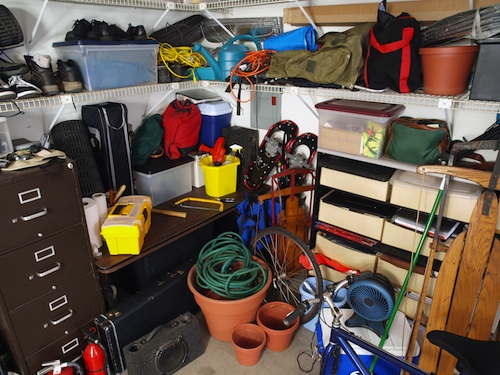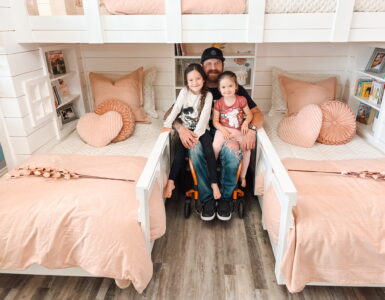Is your stuff taking over your house? Find out how to tap into the emotions that keep you from letting go and de-clutter your life.
Studio 5 Contributor and therapist, Julie Hanks, explains why we hang on to stuff and how to let it go.
In recent years shows about home organization have cropped up on just about every network. From the Style Network’s Clean House, A&E’s Hoarders, to HGTV’s Mission: Organization, we are obsessed with people and their “stuff”; with watching self-proclaimed “pack rats” learning to de-clutter and transform their homes and their lives.
Just like excessive clutter and collectibles can get out of control, an excessive focus on cleanliness and order can become problematic. I call this end of the spectrum the “neat freaks”. In April Women’s Health Magazine I was interviewed for an article called “Worried Sick” about a woman’s story of becoming obsessed with cleaning and detoxifying her home. Read the article online.
Why We Hold On To Stuff
Perfectionism
Believe it or not, just like neat freaks, pack rats are often perfectionist, too. But, instead of wanting a perfectly organized bookshelf, a toxin free home, or uniformed stripes on the vacuumed carpet, “pack rats” are paralyzed by not being able “to do it all” says Judith Kohlberg, author of Conquering Chronic Disorganization (source). Messy folks tend to feel overwhelmed by deciding what to keep and what to let go of, so they put the decision on the shelf, literally.
Solution: Decide On the Spot
Remember, there is no “wrong” choice. Too often small decisions feel like moral issues when they are merely preferences or benign choices. Dr. Gerald Nestadt Director of Johns Hopkins Obsessive Compulsive Disorder Clinic suggests that when you pick something up is the time to decide its fate. Either put it in its place or throw it away (source). This is a means of preventing unnecessary clutter from ever entering the house.
My kids bring stacks of papers home each week and I frequently move the same piles of papers to several different locations around the house for months. But since working on this segment, I’ve actually tried to decide the fate of each paper the moment I touch it and it works! My kitchen counter isn’t cluttered with various piles of school papers. The things I decide to keep are stacked in a cute basket on the counter.
Solution: Face Your Fears
Ask yourself what’s the worst thing that can happen if I throw this paper away or if you donate this piece of furniture? Is your fear that you might regret it? Is it that someone may be upset with you? That may have to pay to replace it? My favorite question to ask myself is “Can I buy it back on Ebay if I change my mind? ”
Several years ago I worked with an overwhelmed client whose home was littered with piles of books, papers, clothes, and she felt unable to make decisions about what to keep and what to get rid of. Her daughters didn’t want to have friends over because they were embarrassed of the clutter and chaos. My client’s family of origin didn’t have enough money to provide for my client’s needs or wants when she was a child. Through therapy she discovered that she was holding onto things because she was afraid of not having enough, like she felt as a child. Being surrounded by “stuff” gave her a sense of security that she and her family would always have more than enough. Through facing her fear of not having enough, and through grieving her early losses and unmet needs, my client was able to find the motivation to let go of much of the possessions she was clinging to.
Sentimentality
You may hold on to things as reminder of fond memories of the past, of close relationships, or of people who have passed on. Consider that the meaning isn’t in the object itself, but in the meaning you ascribe to that particular treasure. You have the power to change the meaning you give to an object.
Solution: Keep Just One
Holding onto boxes of every piece of art that your child draws doesn’t freeze time. Saving boxes of clothing from your great grandma’s closet that you’ll never wear won’t bring her back to life. So, hold on to one of the dresses or your child’s favorite drawing and let the rest go.
I recently posed the question on Facebook “What things do you collect and find it hard to let go of?”. The most common answer was “things that my children have made”. Art projects, papers and cards made by your children are precious gifts, but you don’t have to keep ALL of them. Try applying this rule and keep one per year.
Solution: Take a Photo
If there’s an item with particular meaning or special memory associated with it take a photo of it before you toss it, sell it, give it away, or donate it. Just because an item is associated with a special memory doesn’t mean that you have to keep the actual item.
This idea recently came up in a conversation with my mom, who collects vintage kitchen items. I asked her what it was about vintage kitchen items that were so sentimental. She described memories of her mother in the kitchen. The kitchen was the heart of my mother’s childhood home, and subsequently the kitchen was also the heart of my childhood home as my mom raised 9 siblings who are all grown. I suggested to my mom that she take photos of her favorite items and make a collage on her kitchen wall instead of cluttering up her home by keeping all of the actual items in her living space.
Frugality
“I might need it someday” or “I paid for this” aren’t necessarily good reasons to hold on to clutter things but are common reasons for doing so. While being frugal is an important trait for financial responsibility, it can become too much of a focus and lead to holding on to too much stuff. It’s crucial to balance financial concerns with the emotional and relational costs of having a disorganized or in extreme cases, a hazardous environment.
Solution: Toss It After 2 Years
You know those partially finished crafts that you bought, or those piles of fabric collecting dust, or that closet full of old clothes that you’re holding on to just in case you get to that size again, or those shelves of books you haven’t touched in over a decade? If you haven’t touched something for two years then maybe it’s time to let them go.
According to a recent survey on SmartShopper, the average woman owns about 17 pair of shoes (source). I own 17 multiplied by 7! I realized that my shoes represent being prepared for any event, and they represent that I have options in my life. I also realized that some are also attached to memories. So, I am challenging myself to give away the shoes I haven’t worn for 2 years.
Solution: Put People Before Things
If there’s no place for company to sit down because your couch is covered with collectibles, or your family is standing while eating dinner because the dinner table is covered with boxes of your treasures your are paying a high relational cost. If your stuff is taking priority over your relationships or starting to impact your sleep, work, and other parts of your life its time to take action and ask for professional help. If your piles of stuff put your family’s health at risk or create physical danger it’s time to seek professional help to understand the emotional and mental roots of you’re your relationship with your stuff.
In an A&E’s Hoarders episode a grown woman Darcy shares her pain about her mother choosing to live with “nameless faceless trash” first, and has distanced from her Mom. This extremely sad case illustrates how out of control things can become when you cling to things over people. Watch A&E’s Hoarders Episode 26.
Julie de Azevedo Hanks, LCSW is a therapist, self & relationship expert, media contributor, and director of Wasatch Family Therapy. Visit www.wasatchfamilytherapy.com for individual, couple, family, & group counseling services designed to strengthen you and your family. We treat mental health and relationship problems in children, adolescents, and adults.
For additional emotional health & relationship resources connect with Julie at www.juliehanks.com.















Add comment